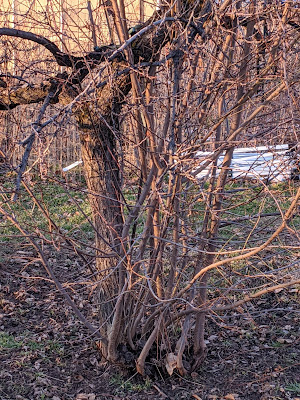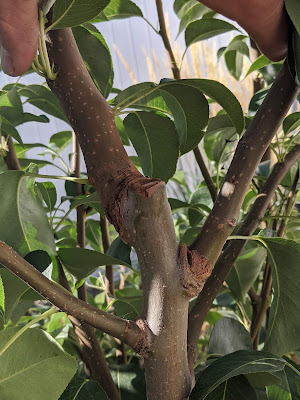Fruit Tree Pruning Calendar
If fruit tree pruning is defined as cutting away unwanted branches from a woody, fruit producing plant, then it makes sense that this garden task is done throughout the entire year, but it happens in several different ways and in several different seasons. Many gardeners want to know when on the calendar pruning tasks should occur, but it's different in different climates and it even differs from one year to another.
If you would like to get regular updates about the care and pruning of fruit trees, please subscribe here:
The following is a list of the many different forms of pruning and when they can be done on the calendar. Because the readers of this blog span a wide array of growing zones and climates, I will not be including specific dates to each of these fruit tree pruning tasks, but instead I will attach them to the seasons and let you decide when on the calendar to schedule them.
Winter Pruning
Let's start our journey in the middle of winter. There really isn't much going on in the garden this time of year. Maybe you're just looking at squirrels and birds at the feeder and waiting for seed catalogs to come in the mail. Is there any pruning that needs to be done this time of the year? No, but would it be bad to do some pruning now. No.
Find out when is the best time to prune fruit trees.
Spring Pruning
Late winter and early spring, when fruit trees start to show signs of change is when the majority of your structural, maintenance, and corrective pruning should occur. This allows you to make cuts without buds, blossoms, and leaves getting in your way. It will also allow for your tree to start sealing off each and every pruning cut immediately after the chore is done. In addition, your trees will have an entire growing season to recover from the damage done.
Find out if it's okay to prune fruit trees when then are in full bloom.
Summer Pruning
Once the bulk of your pruning has been done, you could do nothing until the following spring, but there are a few things that you can do throughout the year to get a better harvest and make your spring pruning easier.
Suckers!
Suckers are branches that grow from below the graft union. These branches won't produce the fruit that you want from you tree and as they grow, they take energy from the rest of the tree. Every time you see suckers growing from the base of you tree, you can pull them off without the use of pruning shears. Consistently tearing them when they are tender and herbaceous will eventually prevent them from growing back in the future.
Water Sprouts
Water sprouts are the fast growing branches that grow as a response to your spring pruning. They do serve a purpose. Your tree is sending up new leaves and branches where it thinks it can capitalize on as much sunshine as possible. It uses this light to create sugars that it uses to feed itself. Sometimes it needs this energy to repair itself from your pruning, sometimes it's just greedy and wants more than it needs.
Just like with suckers, some water sprouts can be removed without the use of pruning shears when they are still tender. If you remove a few of the water sprouts where they are not needed you can simplify your pruning on the spring and prevent your tree from wasting energy on unneeded branches.
June Drop
Fruit from your trees should be thinned as soon as possible to prevent your tree from growing too much fruit and breaking branches under the heavy fruit loads. Thinning will also keep your fruit tree from wasting energy on fruit that it can't support to maturity. Fruit trees will self thin if there is fruit on the tree that is not receiving enough light. This self thinning is often referred to as June drop. June Drop can be prevented if you thin out some of the new water sprouts to allow for more sunlight into the canopy of the tree.
Tipping
Tipping young fruit trees in the early summer will cause the new growth to fork. This is a great way to help your fruit trees fill out and become less leggy.
Fall Pruning
Pruning in the fall is not usually the best time of the year, but there are a few exceptions. Some large apple trees can be pruned in the fall as the leaves are falling. This will pull some of the energy found in the bark tissue out of the tree before it is stored in the root system for the winter. Why would one do this? because some fruit trees need to go on a diet. They spend so much energy on growing water sprouts that they shade out the fruit on the older, more mature spurs. Yes, fall pruning will expose pruning cuts to cold temperatures all winter long and slow down the healing process, but this to will, in a way, cauterize the cuts and prevent excessive water sprout growth in the spring.
Winter Pruning
So now we are back to winter. I know we said that watching birds and waiting for magazines was about the only thing to do in the winter, but I say spring will be here before we know it and there is a lot to do that time of year, so I recommend getting your pruning done as soon as possible, even if there is snow on the ground.
If you would like to learn more about the care and pruning of fruit trees, please browse our 100+ fruit tree articles here, join our Backyard Fruit Growers Facebook Group, and take our free Fruit Tree Pruning Course. Also, please subscribe to our Fruit Pruning YouTube Channel.












can you please make your pruning calendar available for print? it is so small I can barely read it and when I try to enlarge it the wording is blurred
ReplyDeleteIf you click on the image, your browser should open a new tab with a larger version of the image.
Deletewhat about pruning at summer soltice? i read where if you do major cut back then to keep tree shorter that it won't grow back as quickly.
ReplyDeleteYou can prune fruit trees any time of the year. Your tree will respond differently at different times of the year.
Delete